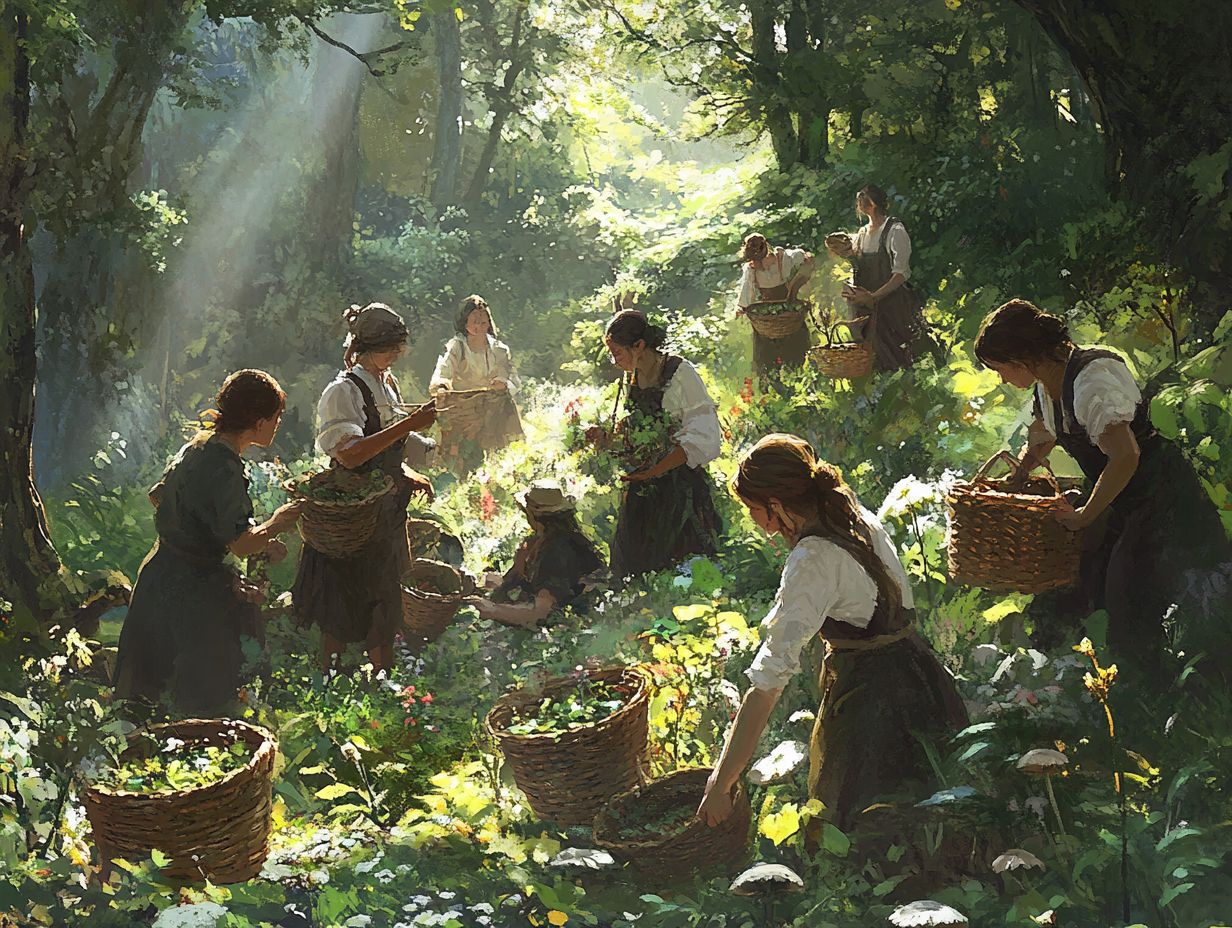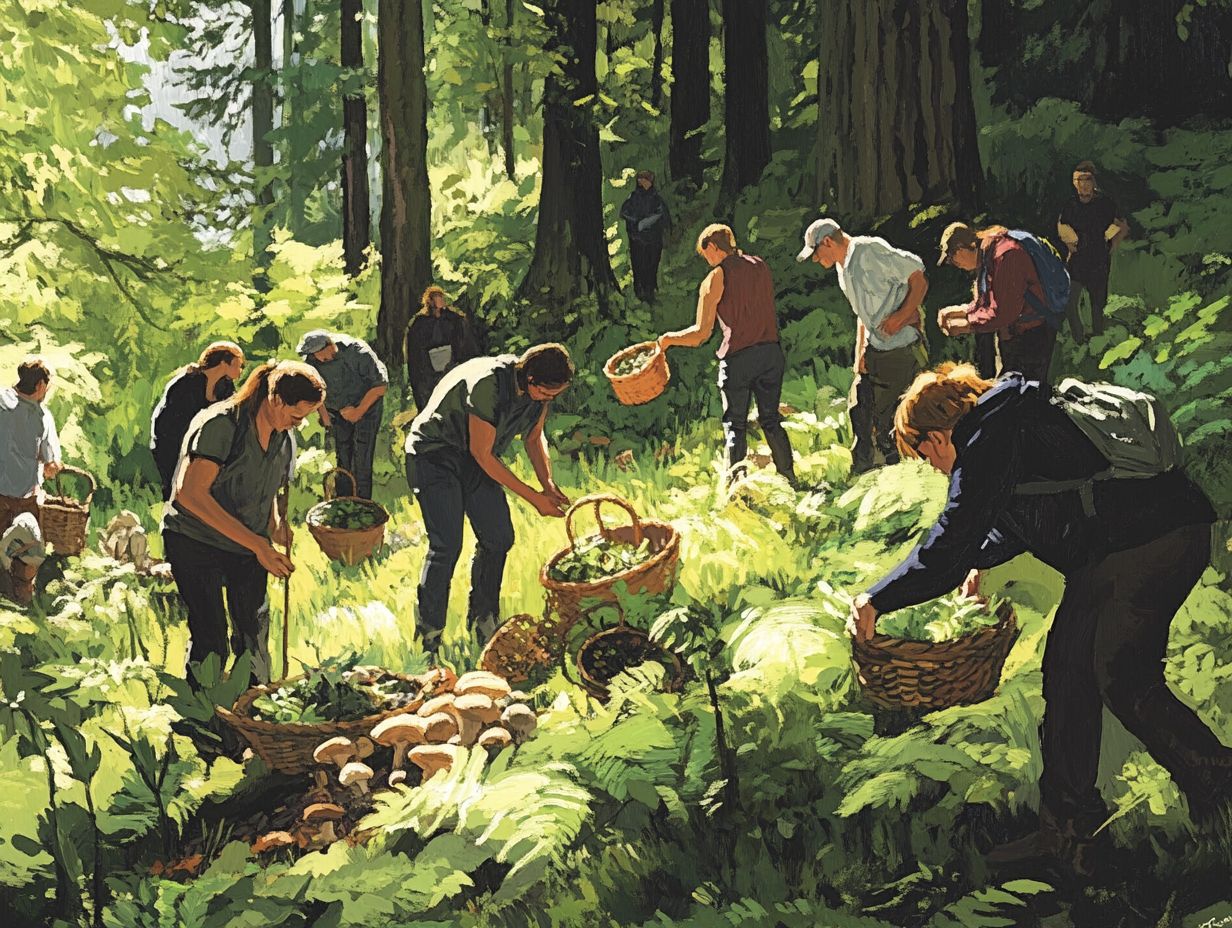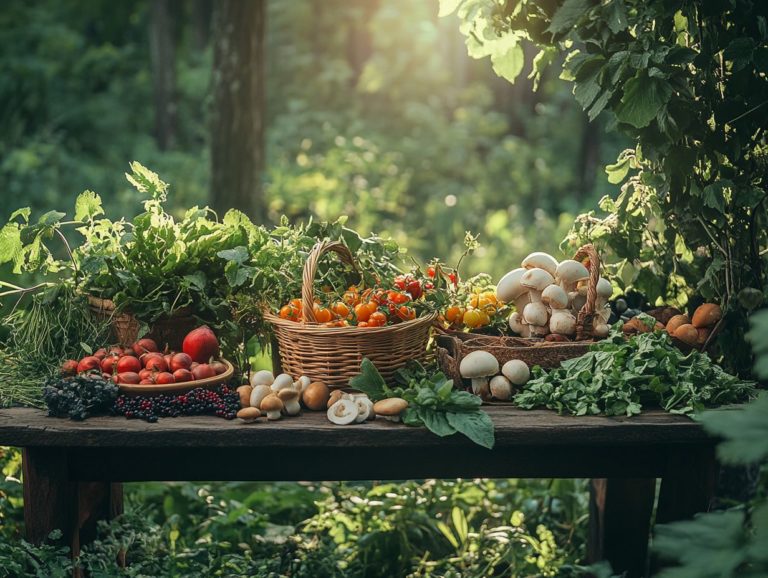Foraging and its Impact on Local Communities
Foraging is more than just finding food; it s a profound practice that intricately weaves your connection to nature and cultural heritage.
This exploration delves into the rich history of foraging, revealing traditional techniques and timeless tools that have accompanied this art through the ages. You ll discover how foraging influences local communities, positively shaping culture and economy while addressing potential environmental concerns.
Engaging in this ancient practice fosters a profound connection to the land and promotes sustainability by encouraging you to seek food sources beyond the confines of industrial agriculture.
Initiatives aimed at reviving foraging are on the rise, inviting city dwellers to venture into local green spaces and uncover delightful edible gems.
The health benefits of consuming wild plants are remarkable. They are typically rich in nutrients, vitamins, and antioxidants, offering a delicious alternative to processed foods while enhancing your overall well-being.
Contents
- Key Takeaways:
- Traditional Foraging Practices
- Impact of Foraging on Local Communities
- Sustainable Foraging Practices
- Alternative Sources of Food for Local Communities
- Frequently Asked Questions
- What is foraging and how does it impact local communities?
- What are the benefits of foraging for local communities?
- How does foraging affect the environment and natural resources?
- What role does foraging play in preserving traditional knowledge and cultural practices?
- Are there any risks or hazards associated with foraging?
- How can individuals support foraging and its impact on local communities?
Key Takeaways:

- Foraging is a time-honored tradition, rich in history, passed down through generations.
- Foraging can positively influence local communities by preserving cultural traditions and boosting economies, but it also has potential environmental impacts.
- It is vital for foragers to practice sustainable methods and consider alternative food sources to ensure the long-term well-being of both local communities and the environment.
Defining Foraging and Its History
Foraging gathering wild edible plants like wild strawberries and wild garlic has woven itself into the fabric of human history, offering sustenance and a sense of cultural identity, especially among indigenous communities.
The knowledge passed down about how to gather food from nature, often referred to as traditional ecological knowledge, has been lovingly passed down through generations, ensuring that local biodiversity is cherished and sustained.
Influential figures like Richard Maybey have played a pivotal role in bringing foraging into the spotlight through works such as Food for Free, which highlights the importance of recognizing the edible treasures that nature provides.
In today’s urban landscapes, the value of this connection has been long appreciated by indigenous communities, who rely on foraging for both nourishment and rich cultural traditions, often incorporating rituals centered around their wild harvests. Understanding the connection between foraging and local ecosystems is vital in preserving these practices.
Traditional Foraging Practices
Traditional foraging practices encompass a rich tapestry of methods and tools that have developed over time, weaving together ecological knowledge and cultural identity to cultivate sustainable food systems.
Engaging in these practices not only nourishes the body but also enhances community well-being by fostering a deep connection between individuals, nature, and the urban landscapes that surround them.
Methods and Tools Used
Foraging methods encompass a range of techniques for identifying and gathering wild edible plants, blending traditional wisdom with modern tools to enhance both efficiency and safety in your food production endeavors.
Among these plants, Ginkgo and Pokeweed shine with their unique flavors and nutritional perks, but you ll need to exercise caution when identifying them. As a beginner, consider investing in a quality field guide and a reliable foraging basket to collect your discoveries. It s essential to learn how to accurately spot these plants, as some can pose risks if misidentified.
Emphasizing sustainable foraging practices is key; take only what you need, leaving ample resources for the ecosystem to flourish. This not only preserves biodiversity, defined as the variety of different species in nature, but also nurtures a deeper appreciation for the richness that nature provides.
Join a local foraging group today to learn more about gathering food from nature!
Impact of Foraging on Local Communities

Discover how foraging positively impacts communities and the environment.
The impact of foraging on local communities is profound. It fosters food justice, enhances mental clarity through a connection with nature, and reinforces cultural identity through shared traditional practices, as explored in the future of foraging communities.
As urban foraging gains momentum, it serves as a remedy for lack of connection with nature. This practice links individuals to their surroundings and one another while promoting food justice.
Positive Effects on Culture and Economy
Foraging has a remarkable impact on both culture and the economy, acting as a powerful catalyst for community well-being. It enhances cultural identity and promotes sustainable food systems that enrich urban landscapes.
As you explore foraging, you uncover a treasure trove of edible plants. This helps invigorate local economies through lively food markets and engaging workshops.
These events create opportunities for local foragers to sell their discoveries, supporting small businesses and encouraging a deeper appreciation for the flavors around you.
In one town, a seasonal foraging festival has blossomed into a beloved tradition. It attracts both residents and visitors, supporting local cafes and artisans.
Workshops led by experienced foragers educate participants on sustainable practices while reinforcing cultural connections. Such experiences remind us of communities’ ancestral ties to land and food, fostering economic resilience and a shared sense of heritage.
Negative Effects on Environment and Sustainability
While foraging offers many benefits, it can also pose challenges for the environment and sustainability. Unchecked foraging practices can deplete native species and spread invasive ones, raising questions about the impact of foraging on biodiversity.
This paradox highlights the need to embrace sustainable foraging practices. These practices focus on gathering wild food while safeguarding local ecosystems.
For instance, overharvesting can diminish plant populations, disrupting the fragile balance that supports various animal species dependent on them for survival.
Introducing foraged invasive species to new environments can outcompete native plants, ultimately undermining biodiversity.
To navigate these challenges effectively, it s essential to educate yourself on identification techniques, the right seasons for sustainable harvesting, and the crucial role each species plays within its ecosystem.
By striking a balance between enjoyment and stewardship, you can join the movement to make a positive impact on your environment through your foraging efforts.
Sustainable Foraging Practices
Sustainable foraging practices are vital to maintaining ecological balance and preserving biodiversity. By adopting these practices, you ensure that wild edible plants and their natural habitats are safeguarded for future generations.
How to Forage Responsibly

To forage responsibly, follow guidelines that respect wild edible plants and their ecosystems. This practice ensures your harvesting doesn t compromise biodiversity or disrupt local wildlife.
Take the time to accurately identify species, as some edible plants have toxic lookalikes that could pose serious health risks. Understanding local regulations is crucial since many areas impose specific rules to protect vulnerable species and their habitats rules that future foragers will depend on.
Engaging with indigenous ecological knowledge enriches your understanding of local flora and fauna. This knowledge provides insights into sustainable practices refined over generations.
Prioritizing sustainability in your foraging efforts means harvesting only what you need. Avoid over-exploitation and ensure there s enough left for wildlife and plant regeneration.
Alternative Sources of Food for Local Communities
Exploring alternative sources of food within local communities is vital for creating sustainable food systems. This approach enhances community well-being, especially in urban environments, where traditional foraging might be restricted. Understanding the impact of foraging techniques on biodiversity can further support these efforts.
By seeking out diverse food options, you can contribute to a more resilient and thriving community ecosystem.
Exploring Other Options
Exploring alternative food production options, like community gardens, opens essential pathways for you and your community to create sustainable food systems and strengthen fair access to healthy food for everyone. Innovative strategies encourage healthier eating habits and cultivate a sense of belonging among residents.
Take local urban farms, for example; they have transformed vacant lots into vibrant, productive spaces where you can engage in hands-on agricultural practices. Food co-ops, too, present an alternative marketplace, granting you access to fresh, locally sourced produce while supporting local farmers.
By participating in these initiatives, you deepen your connection to your food and significantly reduce the barriers that often stand in the way of accessing nutritious options.
Frequently Asked Questions
What is foraging and how does it impact local communities?

Foraging means gathering wild foods like plants and mushrooms. It helps communities by providing a sustainable food source and promoting biodiversity while also preserving local traditions.
What are the benefits of foraging for local communities?
Foraging offers nutritional and economic benefits while promoting a deeper connection to the natural environment and encouraging self-sufficiency, but it’s important to consider the ecosystem impact of foraging.
How does foraging affect the environment and natural resources?
Foraging can promote biodiversity and sustainable use of resources, but what are the environmental impacts of foraging? Over-foraging or irresponsible practices can lead to depletion of certain species and damage to ecosystems.
What role does foraging play in preserving traditional knowledge and cultural practices?
For many indigenous and rural communities, foraging is key to their culture and traditional way of life. It allows for the passing down of knowledge and skills, preserving cultural practices and promoting a sense of identity and community, while also understanding the impact of foraging on wildlife.
Are there any risks or hazards associated with foraging?
While foraging can be rewarding, it is important to be aware of potential risks like poisonous plants and contaminated food sources. Proper education and caution are essential to ensure safety.
How can individuals support foraging and its impact on local communities?
Individuals can support foraging by learning about local regulations, backing small-scale foragers, and advocating for the protection of natural resources and traditional knowledge. Start foraging today! Discover the delicious wild foods in your backyard.






